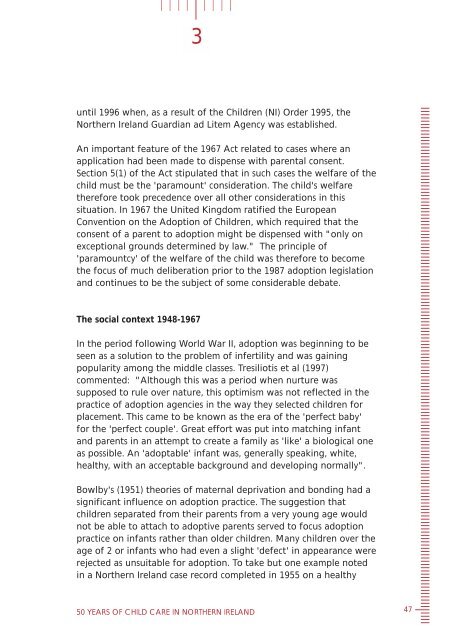childcare-50years
childcare-50years
childcare-50years
You also want an ePaper? Increase the reach of your titles
YUMPU automatically turns print PDFs into web optimized ePapers that Google loves.
3<br />
until 1996 when, as a result of the Children (NI) Order 1995, the<br />
Northern Ireland Guardian ad Litem Agency was established.<br />
An important feature of the 1967 Act related to cases where an<br />
application had been made to dispense with parental consent.<br />
Section 5(1) of the Act stipulated that in such cases the welfare of the<br />
child must be the 'paramount' consideration. The child's welfare<br />
therefore took precedence over all other considerations in this<br />
situation. In 1967 the United Kingdom ratified the European<br />
Convention on the Adoption of Children, which required that the<br />
consent of a parent to adoption might be dispensed with "only on<br />
exceptional grounds determined by law." The principle of<br />
'paramountcy' of the welfare of the child was therefore to become<br />
the focus of much deliberation prior to the 1987 adoption legislation<br />
and continues to be the subject of some considerable debate.<br />
The social context 1948-1967<br />
In the period following World War II, adoption was beginning to be<br />
seen as a solution to the problem of infertility and was gaining<br />
popularity among the middle classes. Tresiliotis et al (1997)<br />
commented: "Although this was a period when nurture was<br />
supposed to rule over nature, this optimism was not reflected in the<br />
practice of adoption agencies in the way they selected children for<br />
placement. This came to be known as the era of the 'perfect baby'<br />
for the 'perfect couple'. Great effort was put into matching infant<br />
and parents in an attempt to create a family as 'like' a biological one<br />
as possible. An 'adoptable' infant was, generally speaking, white,<br />
healthy, with an acceptable background and developing normally".<br />
Bowlby's (1951) theories of maternal deprivation and bonding had a<br />
significant influence on adoption practice. The suggestion that<br />
children separated from their parents from a very young age would<br />
not be able to attach to adoptive parents served to focus adoption<br />
practice on infants rather than older children. Many children over the<br />
age of 2 or infants who had even a slight 'defect' in appearance were<br />
rejected as unsuitable for adoption. To take but one example noted<br />
in a Northern Ireland case record completed in 1955 on a healthy<br />
50 YEARS OF CHILD CARE IN NORTHERN IRELAND<br />
47


